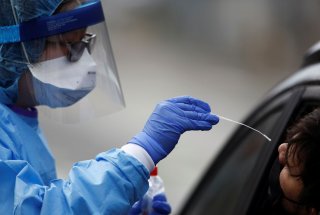Will the Army’s New Nasal Swabs Catch the Coronavirus?
We can only hope.
(Washington, D.C.) U.S. Army scientists and engineers have been working with Harvard University to design, prototype and evaluate new nasal swabs needed to test for COVID 19 -- as a way to address the current crisis with available coronavirus test kits and assess possibilities for large-scale production of new swab configurations.
An Army-Harvard team of expert scientists have been performing “specialized testing” of industry built swab prototypes to ensure that new, alternative designs meet the requisite performance and diagnostic parameters.
“A key shortfall has been in the nasopharyngeal swabs used to take samples from patients’ nasal passages. Hospitals have run out and are often unable to test patients,” David Accetta, Chief, Public Affairs, U.S. Army Combat Capabilities Development Command Soldier Center, Army Futures Command, told Warrior Maven (or you can say told Fox News here if you want, as you are getting it first - either way- it is exclusive) in a written statement.
The Nasopharyngeal swabs, which reach through the nasal passage to the throat to check for the virus, are being assessed at the Army CCDC’s, Soldier Center’s Testing Lab, Natick Soldier Center, Mass.
The goal is to not only identify new commercially available nasal swabs for testing but to also ensure that they can be mass-produced and distributed, given the pressing demand.
The Army’s CCDC is collaborating with Harvard and Boston’s Beth Israel Deaconess Medical Center (BIDMC) to evaluate the nasopharyngeal swabs produced by industry and, according to Army experts, “ensure a new design that would be producible and safe for patients undergoing COVID-19 testing.”
“Our engineers' work is focused on developing a test protocol for Harvard to ensure that alternate swab designs can be properly evaluated to ensure safety and effectiveness. This is critical as a swab that would break in the patient's nasal passage would have to be surgically removed,” Accetta told Warrior (or Fox) in a written statement.
Some of the prototypes under evaluation were produced using additive manufacturing, or 3D printing techniques.
“Prototypes were rapidly produced (24 hours) and delivered to Harvard University and BIDMC for evaluation of the ability to apply nylon fiber and sterilize as well as suitability for use,” Matt Hurley, a CCDC Soldier Center mechanical engineer working on the effort, told Warrior. “We are conducting tensile and torsional testing to compare the mechanical properties of printed swabs that were reasonably similar to the commercial-off-the-shelf solutions, to prevent the swabs posing a risk of failure while in use within a patient's nasopharynx. ”
“We are trying to help the Harvard-led consortium to identify a safe alternative source of supply,” he added.
Finding the optimal testing equipment and procedures is quite naturally a challenge for experts working quickly to understand a new, somewhat unexpected virus, according to March 20 report from the American Society for Microbiology COVID 19 Summit called the “Value of Diagnostic Testing for SARS-COV2/COVID 19.”
“Since SARS–CoV-2 is a new virus, there is little evidence to fall back on for test utilization and diagnostic stewardship,” the report states….(The virus itself is called SARS - Severe Acute Respiratory System Coronavirus 2, and the resulting disease is called COVID 19)
The essay reinforces the significance of the current Army-Harvard work by explaining that “further analysis of testing procedures, technologies and diagnostics are needed to continue to better understand variability in the performance characteristics of the various tests (e.g., sensitivity and specificity).”
Monitoring test performance is critical, the essay explains, due to the “potential for the virus to mutate.”
Ultimately, as greater numbers of patients get tested for the virus, decreasing the time to results will be crucial.
“Development of rapid, point-of-care diagnostics is a gap and should be a priority,” the American Society for Microbiology report explains.
While the effort is currently high-priority and fast-tracked, some of the new swab configurations will need quick FDA approval before being distributed, so an exact timetable for when they might be available is not precisely clear. However, developers are optimistic that something new could be ready quickly.
This article by Kris Osborn originally appeared in WarriorMaven in 2020.
Kris Osborn previously served at the Pentagon as a Highly Qualified Expert with the Office of the Assistant Secretary of the Army - Acquisition, Logistics& Technology. Osborn has also worked as an anchor and on-air military specialist at national TV networks. He has appeared as a guest military expert on Fox News, MSNBC, The Military Channel and The History Channel. He also has a Masters Degree in Comparative Literature from Columbia University.
Image: Reuters

